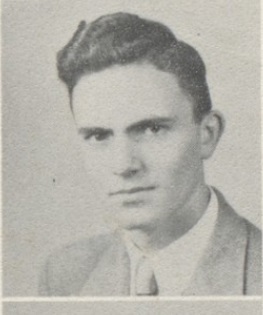Wilbur Turner:
CLASS OF 1952

Central High SchoolClass of 1952
Elizabeth city, NC
Wilbur's Story
This is another true story about an event in my life when I was 19 years old.
As I may have previously divulged in other stories that at age 19 I was in the US Air Force stationed at Johnson Air Base located about 20 miles from Tokyo, Japan. I was transferred there from Sheppard AFB, Wichita Falls, TX, after completing Aircraft & Engine Mechanic’s School and assigned to the 6th Tow Target Squadron in Japan where the Air Force was using B-26 aircraft to pull targets for Army Anti-Aircraft Batteries and Air Force Fighter Pilots to hone their skills.
Johnson was our home-base and we would fly to two-week temporary duty assignments at different bases in Japan, Okinawa, and South Korea. At that time my title was Flight Engineer, which meant that when flying I sat in the right seat next to the pilot. Our B-26 aircraft were equipped with only one control column located in front of the pilot’s seat on the left.
The occasion was during our return trip from Okinawa; it was raining and we could hardly see our hands in front of our faces as we cruised along at about 8,000 feet over the Sea of Japan. When suddenly our left engine coughed and stopped running; then the right engine did the same. My pilot had been flying jets and wasn’t the sharpest on the functioning of our reciprocating engines, so when this happened we looked at each other and I sensed that he didn’t know what to do so I reached over and thrust the throttles to the Fully Opened position.
When I threw the throttles to Fully Opened both engines started running again. Just a little explanation about what happened is in order at this point. When our engines suddenly stopped running the propellers kept wind-milling but since the propellers were turning the engines instead of the engines turning the propellers we had no power to keep the airplane flying, therefore, we started dropping like a rock. We lost a couple of thousand feet of altitude in those few seconds when the engines were not providing the power we needed to keep the plane moving forward. The only thing necessary to restart the engines at that point was to give them fuel, air, and spark, and let the propellers do their job of rotating them, and when those conditions were met we were off and running again. Once the engines were operating properly we calmed down, looked at our instrument panel, and immediately realized wha...Expand for more
t had happened. Since we were flying at a pretty high altitude and it was raining, ice formed in the carburetor intakes chocking off the flow of air (oxygen); one of the three elements necessary to run an engine (air) was missing so our engines stopped running. The jolt of the throttles being thrust open, while the propellers were spinning the engines caused the engines to suck the ice out of the throat of the carburetors enabling air to flow in again. After that incident, we were off and running (flying) again and the pilot was able to regain our assigned altitude.
Our next task was to keep the situation from happening again. We learned an important lesson that day and lived to tell about it. That lesson was to continuously scan the instrument panel when flying and if any instrument gets out of the green zone and into the yellow or red zone do something as soon as possible to remedy the situation. Both of our carburetor temperature gages were in the red. Our remedy, if we had known what was happening before it happened, would have been to simply adjust the carburetor temperature controls mounted on the control console. These controls divert heated air from the exhaust manifolds of the engines to the intakes of the carburetors, thus keeping ice from forming in the throats of the carburetors.
We escaped a bad situation that day and lived to tell about it, but if we had not been able to restart those engines, most likely we would have been lost forever in the Sea of Japan and no one would have ever known why our plane went down or what happened to the crew of 3 aboard B-26 number 434 268.
It was a rainy day that I’ll never forget. We didn’t know about God’s plan for our lives at that time, but now in hindsight, we know that we were living out the plan He had for us.
Incidentally, in addition to being a flight engineer, I was also crew-chief of the airplane we were flying at the time of our incident.
Each airplane had a yellow space painted on the port side of the fuselage, below the canopy, for the purpose of listing the name of a pilot, the name of the crew-chief, the name of the assistant crew-chief, and the name of a tow-reel operator. Shortly after our incident I became closer to the pilot of the incident and had his name “1st Lt. Casey” (from Goldsboro, NC) painted above my name on the side of my airplane; B-26 number 434 268.
Register for Free to view all details!
Yearbooks
Register for Free to view all yearbooks!
Reunions
Register for Free to start a reunion event!
Photos



